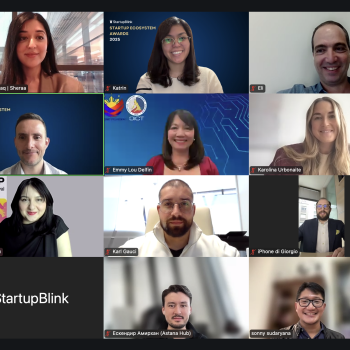
In today’s tech age, Open Innovation has become a necessity. While there is still little less willingness for it, Open Innovation is largely synergistic and symbiotic process beneficial to all. Open Innovation is defined as the process of taking ideas from outside to benefit a business or an innovation process that allows knowledge to flow between organizations. It is the converse of a traditional R&D approach. Open Innovation heavily relies on external ideas and technologies. R&D or closed innovation was the most preferred method of innovating earlier when there was lesser connectivity, communication and collaboration. But with changing times, smarter corporations are quickly adapting their strategies to be more inclusive of open innovation. We at StartupBlink have been early adopters of Open Innovation and have facilitated several meaningful discussions between corporations and innovative startups.
Why is Open Innovation useful?
For larger businesses and corporations, the most common way of innovating is to have an R&D center which turns out to be very time consuming. Also, corporations have different cultural makeup than startups. While startups are faster and more innovative in their ideas, approaches and technologies. Since most startups have a fresh way of looking at issues and have new knowledge, it really adds value for bigger corporates to collaborate and work with such startups. Corporations today are ready to embrace a culture of experiments.
Startups may be exceptional in exploiting new technology, ideating newer marketing methods, entering different industry sectors and even having novel business ideas. Being dynamic and mostly restricted financially, their success metrics might be largely based on the % growth every month. And the ideas that aren’t promising may need to be shelved immediately. In that way, Open Innovation is a very synergistic process benefiting both startups and corporates by providing financial resources for startups and innovative ideas to corporations that can be developed further.
Reasons for corporates to choose Open Innovation:
- Resolving internal issues – Like cost cutting, increasing process efficiency, reducing Time-to-Market (TTM), reducing R&D costs, changing status quo and adapting with the times
- External goals – Like launching a new product line, entering a new market, creating a market differentiation, competitive edge, creating exponential sales and nurturing future clients, brand awareness and virality, risk minimization
Reasons for startups to participate in Open Innovation:
- Funds shortage – Most startups are short of funds and participating in Open Innovation can bring a great influx of money
- Infrastructure limitations – Startups tremendously value the global infrastructure, strong brand association, access to in-depth data, regulatory process compliance, etc. of corporates
How can startups and bigger organizations participate in Open Innovation?
There are several ways in which startups and corporations can come together to work and create innovative products:
- Partner collaboratively: This is a way of productively innovating. By partnering with the right startups in their target industry, corporations can benefit from Open Innovation without having to invest a lot of capital required for acquiring another business. Terms of partnership can be dynamic.
- GTM strategy: This is when a corporation utilizes the Open Innovation principle to launch it’s own Go-To-Market strategy. The best example of this is Apple’s iPod which wasn’t developed in-house but for which a team was assembled from outside. iPod, which became an instant success, was launched just in 6 months owing to external talent and strategies.
- Contests and events: Corporations can organize events where several startups can participate to solve an issue, have productive discussions and share ideas. It can be beneficial for startups to win such accolades to increase their momentum apart from cash flows.
- Accelerators, incubators and startup programs: Lots of corporations and bigger organizations run their own accelerators and incubators to mentor fresh and talented startups. Many also have their own startup programs where they encourage qualifying startups with better tools. Example, ANSYS Startup Program enables qualifying hardware startups to get their engineering simulation and virtual prototyping tools at a heavily discounted and affordable price.
- Equity and M&A: Corporates can make equity dealings with startups to get innovative ideas from them. And as a last step, Mergers and Acquisitions are a great way of getting avant-garde startups onboard. Most companies looking to acquire smaller companies look at innovation as the biggest factor for the acquisition. Such deals are often strategized so that businesses can enter into new streams often with innovation as a driving force. Many organizations have a dedicated team looking out for innovative startups with cutting edge technology that they can acquire.
Phases of Open Innovation
Phase1:
This revolves around why a corporation needs Open Innovation and what do they seek to gain and achieve out of it. This phase mostly relates to Internal searching for answers by corporations. They need to establish what are their weak spots, improvements or developments and their reasons for nurturing startups. Corporations need to understand that they will need to adapt to become early adopters. In this process, they can speak to expert companies like StartupBlink, a global startup ecosystem map, where we can assist in strategies facilitating Open Innovation.
Phase 2:
The second phase revolves around building infrastructure to support Open Innovation. Important aspects of this phase are figuring the budget, defining exact value that will be gained, creating compatible culture for companies to collaborate, etc.
Phase 3:
The next phase is to locate the startups that are valuable to a corporation. Internet has been a great facilitator. Additionally on platforms like StartupBlink it is easy to locate and filter startups by industry, niche and location. Corporations can use marketing resources like creating landing pages, announcing competitions and events, social media promotion etc. to locate interested startups.
Once the above phases are completed, integration with the startup occurs. After facilitating several Open Innovation projects between organizations, we recommend that the whole process should be done slowly, allowing for trial and error and providing sufficient time for adjusting and a cultural shift.
Criteria for selecting innovative startups
For corporations, it is crucial to select the right startups that match with their long term vision, have similar work ethics and culture and are in line with their strategic goals. Once they arrive at a target list of such startups, it is important to select wisely as per the following criteria:
- Which industry does the startup belong to and if that is something the corporate looks out for?
- How many years has the startup been in market? Five years could be a good starting point to have validated proof of concept.
- Are there any milestones within the company like has it been registered, have they achieved break even, etc.?
Conclusively, the whole concept of Open Innovation is the most beneficial development of the last decade. Albeit slow, we encourage both the corporates and startups to use our platform to start conversations and build partnerships to benefit everyone.






